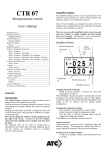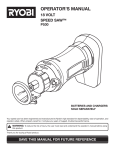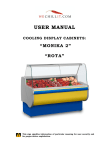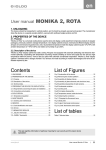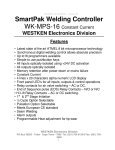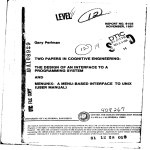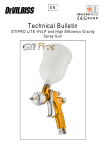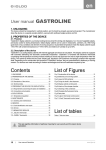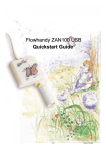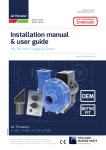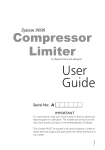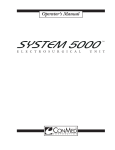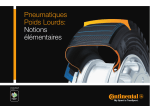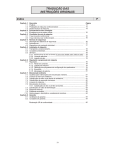Download to MVS31 XP and MVS35 XP
Transcript
Minipack-torre S.p.A. Via Provinciale, 54 - 24044 Dalmine (BG) - Italy Tel. (035) 563525 – Fax (035) 564945 E-mail: [email protected] http://www.minipack-torre.it IT EN DE FR ISTRUZIONI PER L’INSTALLAZIONE, L’USO E LA MANUTENZIONE INSTALLATION, OPERATION AND MAINTENANCE INSTALLATIONS-, GEBRAUCHS- UND WARTUNGSANLEITUNG INSTRUCTIONS POUR L’INSTALLATION, L’EMPLOI ET L’ENTRETIEN IT EN DE FR MACCHINA CONFEZIONATRICE SOTTOVUOTO VACUUM PACKING MACHINE VAKUUMMASCHINE MACHINE CONFECTIONNEUSE SOUS-VIDE MV31 XP IT EN DE FR MV35 XP LEGGERE ATTENTAMENTE QUESTE ISTRUZIONI PRIMA DI USARE LA MACCHINA BEFORE USING THE MACHINE PLEASE CAREFULLY READ THE INSTRUCTIONS BITTE LESEN SIE DIESE ANLEITUNG GENAU DURCH, BEVOR SIE DIE MASCHINE BENÜTZEN PRIERE DE LIRE ATTENTIVEMENT CE MANUEL D’INSTRUCTIONS AVANT D’UTILISER LA MACHINE IT Italiano Pagina 01 EN English Page 21 DE Deutsch Seite 41 FR Français Page 61 DOC. N.FM111158 REV. 01 ED. 10.2013 TRANSLATION OF THE ORIGINAL INSTRUCTIONS Index Chapter 1. 1.1. 1.2. 1.3. Chapter 2. 2.1. Chapter 3. 3.1. 3.2. Chapter 4. 4.1. 4.2. 4.3. Chapter 5. 5.1. 5.2. 5.3. Chapter 6. 6.1. 6.2. 6.3. Chapter 7. 7.1. 7.2. 7.3. 7.4. 7.5. 7.6. 7.7. 7.8. 7.9. 7.10. Chapter 8. 8.1. 8.2. EN Description Page Preface..….….…………………….………………………………………….………… 22 Performances of packaging machine.........…….………………………….………… 22 Technical data of the machine……………………………....……………….………. 23 Pouches features Pouches to use…..................................………...…………………………..………. 24 Machine usage conditions Items that may be packaged…………………………………………………….……. 24 Items not to be packed……......................……..………………………………..……24 Safety standards Warnings.…………………………………………………..………………………….…24 Description of safety stickers.…............................................………..………………26 Individual protection devices……………………………………………………….…. 26 Machine installation Transport and positioning.................…….........…………………………………..… 26 Environmental conditions.........................…….……………………………………... 26 Users…………………..............................……..………………………………………27 5.3.1. Loading the oil in the pump…………………………………………………… 27 5.3.2. Electrical connections..............................……..…………………………..… 27 5.3.3. Gas connections..............................…………...…………………………..… 27 Machine adjustment and setting up Adjustment...............................................……..………………………………….…. 28 6.1.1. Control panel………………………………………………………………….… 28 6.1.2. Switching the machine on…………………………………………………….. 28 6.1.3. Program selection and variable setting……………………………………… 29 6.1.3.1. Main display page (page one)……………………………………..… 29 6.1.3.2. Main display page(page two)………………………………………... 30 6.1.3.3. CONFIGURATIONS display page…………………………………... 33 6.1.3.4. How to enter and modify text………………………………………... 35 6.1.3.5. Setting up label data.…………………………………………….…..…35 Packaging…………………………………………………………………………..…… 36 Alarm messages…..………………………………………………………………..….. 36 Ordinary maintenance Precautions for ordinary maintenance interventions……………………….………. 37 Cleaning of the sealing bar….…………………………………………………..……. 37 Replacement of the Teflon and the sealing blade..……………………………..….. 37 Replacement of the cover gasket…………………………………………………..… 37 Cleaning machine…………..………………………………………………………….. 38 Vacuum pump maintenance……………………………………………….………..… 38 7.6.1. Condition Program………………………………………………….……….…. 38 Problem solving.…………………………………………………………………………39 Wiring diagram.………………………………………………………………………… 39 Pneumatic diagram..………………………………………………………………..…. 40 Disassembling, demolition and elimination of residuals……………………….…… 40 Guarantee Certificate of guarantee…............................….…………………………………..… 40 Guarantee conditions…...............................……………………………………..….. 40 CE declaration of conformity…...................……………………………….………… 81 21 Chapter 1. Description EN 1.1. Preface This manual has been drawn up in compliance with the UNI 10893 standard dated July 2000. It is meant for all users in order to enable them to use the machine correctly. Keep it in a place which can be easily accessed in the proximity of the machine and which is known to all users. This manual is an integral part of the machine for safety reasons. We wish to specify the symbols in use here below in order to improve their understanding. ATTENTION: Accident prevention rules for the operator. This warning indicates the presence of dangers which can injure the person operating on the machine. ATTENTION: Hot parts. Shows the danger of burning, thus involving the risk of a serious accident for the exposed person. WARNING: It indicates the possibility of damaging the machine and/or its components. All reproduction rights of this manual are reserved to the manufacturer. Partial or complete reproduction is forbidden as provided by the law. Descriptions and pictures provided in this manual are not binding. Therefore the manufacturer, reserves the right to make any change considered necessary. This manual cannot be transferred for viewing to third parties without authorisation in writing from the manufacturing company. 1.2. Performances of packaging machine This machine represents what the modern technology of vacuum-packing may express at its best. It is flexible, easily programmable and cheap. It is intended to vacuum-pack foodstuffs by removing oxygen as well as any chemical and biological pollutant present in the environment. To attain the vacuum level you wish, just program the machine in order to remove almost all the air contained in the packet. Your product will preserve its organoleptic features, colour, taste, flavour and nutritive value for a long time. In addition, this machine introduces an important innovation, an exclusive and revolutionary new concept for internal vacuum packaging: vacuum traceability on the packet. This brand new feature, marketed exclusively by Minipack-Torre, can be used to produce one or more adhesive label (when packaging one or more bag simultaneously) displaying the essential product conservation information. It is possible to display a wide range of information, including: packing date, vacuum level, operator name/code, product name, % of inert gases present in the package, expiry date, packet number and the name of the company where the product was packed. The information is customisable and can be set up easily using the electronic LCD interface. 22 Chapter 1. Description EN 1.3. Technical data of the machine MV35 XP MV31 XP I = Electrical connections; H = Gas connection; R = Gas pressure reducer. MV31 XP MV35 XP Package sizes (mm) 610x520x420 710x460x485 Package weight (Kg) 41 53 Machine sizes with closed cover (mm) 390x499x345 402x617x317 Machine sizes with open cover (mm) 390x499x669 402x617x634 Machine weight (Kg) 37 45 Vacuum pump (m³) 6 10 23 Chapter 2. Pouches features EN 2.1. Pouches to use They may be of different thickness (85÷200µm) and shall be both airtight and gastight. Only food packaging pouches can be used. The following table indicates the maximum dimensions of the pouches that can be used with the various machine models. Machine Pouch width open side Pouch length closed side MV31 XP (front bar) MV35 XP (front bar) 305mm 305mm 265mm 265mm The following table indicates the min/max temperature limits the pouches can undergo to. Type of pouch for cooking for storage Minimum temperature Maximum temperature -15°C -20°C +120°C for 30 minutes +70°C for 2 hours; +100°C for 15 minutes. It is recommended to refer to the technical and safety sheets of the pouches in use and to observe the corresponding instructions! Chapter 3. Machine usage conditions EN 3.1. Items that may be packaged This machine can be used to pack the majority of foodstuffs, including: fruit, fish products, dairy products, meat, delicatessen, oven ready products, gastronomic products, dried products, etc. A more complete, although not exhaustive, list can be found in the table on page 30. 3.2. Items not to be packed It is absolutely forbidden to pack the following products which might permanently damage the machine and harm operator: Liquids of any type and density in fragile containers Inflammable and explosive materials Gas bottles under pressure or of any type Bulk or volatile powders (unless a filter is assembled on the pump) Any material and product which might in any way cause the user to be in a dangerous situation and damage the machine. Chapter 4. Safety standards EN 4.1. Warnings It is extremely important to read this entire chapter as it contains important information regarding risks that personnel are subject to in the event of incorrect use of the machine. These basic standards must be observed as well as specific standards applicable in the country of installation. The machine must be installed by trained and authorised technicians. This machine is not intended for use by persons (including children) with reduced physical, sensory or mental capabilities, or lack experience and knowledge, unless they have been given supervision or instruction concerning use of the machine by a person responsible for their safety. Children should be supervised to ensure that they do not play with the machine. Keep children and animals away from the machine when running. Do not allow children to play with the pouches. The machine must be used only for the purpose it was built for. Any other use shall be considered “improper” and therefore dangerous. Never allow unauthorised personnel to perform repairs or other operations on the machinery. The operator must be familiar with all warnings related to the tasks in hand and always be informed by the head of the site regarding risks. Ensure that all clothing is tight fitting, with particular reference to cuffs or other loose clothing. Ensure that all operating areas and transit zones are kept clear, clean and adequately lit at all times. Eliminate all safety hazard conditions before using the machine and always notify the head personnel of any malfunction. 24 Chapter 4. Safety standards EN Never use the machine in the event of fault. Never tamper with safety devices or circuits. Never perform modifications on the machine without prior authorisation from the manufacturer. If the supply cord is damaged, it must be replaced by a special cord or assembly available from the manufacturer or its service agent. The electrical enclosure must remain closed during operation. Smoking is forbidden while the machine is operating! Never performs maintenance and/or adjustments to the machine during operation. Guards may only be disassembled by suitably trained and qualified maintenance engineers. Never operate the machine without all guards fitted. Ensure correct position of all guards before resuming normal operation. If it is necessary to leave the machine unattended, switch it off by turning the main switch to the “0” (OFF) position! The manufacturer declines all liability for damage or phisical injury caused by failure to observe safety standards. THE MACHINE CAN NOT BE USED BY UNTRAINED PERSONNEL! During work pay attention to all hot parts of the machine. The temperature they can reach is so high that it can cause burns. Never use gaseous mixtures in presence of oxygen in a percentage higher than the atmospheric one (~ 19%). Do not touch the sealing blade (16) immediately after sealing. Danger of burns due to hot blade. Do not seal if the sealing wire is broken. Replace it immediately. Do not touch the vacuum pump (23) just after a working cycle. Possibility of burning due to the high temperature the pump may reach In case of a power failure during a working cycle when the cover is closed, do not use any tool in order to force its opening. Wait for the power supply to be restored. Do not place any weight on the cover (18)! Prevent any object from falling on the cover! This can compromise the integrity, causing cracks or damage. Do not proceed with packaging if the cover has cracks or is broken. Replace it immediately. 25 Chapter 4. Safety standards EN 4.2. Description of safety stickers The following safety stickers feature on the machine: On the power input. ATTENTION! Periodically check the correct insulation of the power cable and the integrity of the socket. During machine operation, the inspection panels to the electric system must be correctly fitted. On the sealing bars positioned inside the tank On the vacuum pump positioned inside the machine. ATTENTION! Hot members. It shows the danger of burning, thus involving the risk of a serious accident for the exposed person. On the sealing bars positioned inside the tank ATTENTION! Indicates the danger of burns with risk of accident in case of contact with the hot surface of the sealing bar. On the Plexiglas lid. ATTENTION! Indicates how to clean the lid to prevent damaging it and reducing its transparency or strength. 4.3. Individual protection devices Wear safety shoes that protect feet from impacts, crushing and compression while moving or handling the machine. Wear safety gloves that protect the hands from crushing and mechanical hazards and while moving or handling the machine. Wear safety gloves that protect the hands against cutting risks while changing the sealing blades. Wear safety gloves that protect the hands against the specific risks associated with the materials to be packed (mechanical, chemical) and against coming into contact with the high temperatures present on the seals and/or sealing bars (up to 100°C). Wear safety gloves that prevent the hands from coming into contact with foodstuffs when packaging them. Chapter 5. Machine installation EN 5.1. Transport and positioning When transporting and positioning the machine, it is recommended to handle it with great care! Neither overturn nor tilt the machine! Oil might come out of the pump and damage the machine. Cut the strap with scissors make sure you protect your eyes by wearing glasses and withdraw the cardboard. Cut the strap fastening the machine to the pallet. 5.2. Environmental conditions Lift the machine and place it on the working surface. Make sure the machine is placed in a proper environment without any inflammable and explosive materials or gas. The machine may only be installed on smooth, flat noninflammable surfaces. Leave a minimal space of 0,5m around the machine so that not to obstruct air outlets. Working environmental conditions: Temperature from + 5°C to + 40°C. Relative humidity from 30% to 90%, without condensation. The lighting of the operation room shall comply with the laws in force in the country where the machine is installed. However, it shall be uniform and provide for good visibility in order to safeguard the operator’s safety and health. MACHINE SAFETY FACTOR = IP20 THE AERIAL NOISE MADE BY THE MACHINE IS LOWER THAN 70 dB(A) 26 Chapter 5. Machine installation EN 5.3. Users 5.3.1. Loading the oil in the pump The oil loading operation must be carried out by trained and authorised technical personnel. To access inside the machine, remove the rear panel, using a screw driver to remove the fixing screws. Remove the cap to load oil (21) using the provided wrench and fill the oil tank following the instructions indicated in the pump user manual attached to the machine. MV35 XP (20) Oil discharge plug (21) Oil filling plug (22) Oil inspection plug MV31 XP If the pump has no oil, to load, fully use the provided bottle. 5.3.2. Electrical connections Voltage (V): see data on plate Frequency (Hz): see data on plate Maximum absorbed power (W): see data on plate Maximum absorbed current (A): see data on plate Note: When contacting the Manufacturer, always indicate the model and the serial number specified on the plate on the rear part of the machine. OBSERVE HEALTH AND SAFETY REGULATIONS! If the machine is not equipped with the power supply plug, use a plug that is suitable for the voltage and amperage values described by the rating plate and that can comply with the rules in force in the installation country. GROUNDING OF THE UNIT IS OBLIGATORY! Before executing electrical connections, make sure the mains voltage matches the one on the plate on machine rear and that the ground contact complies with the safety rules in force. In case of doubts about the mains voltage, contact the local public supply Company. Insert the plug on the cable from machine electrical cabinet in a mains power supply socket that can be reached easily by the operator. 5.3.3. Gas connections When carrying out packaging operations in modified atmospheres, use specific gas for food package in compliance with the rules in force about food additives in the country where the machine is used. The gas, which consists of a mixture of nitrogen, carbon dioxide and, more rarely, oxygen and other gases, is a “made to measure” gaseous mixture, depending on the product to be packaged. Never use gaseous mixtures in presence of oxygen in a percentage higher than the atmospheric one (~ 19%). Connect gas attachment, in case the machine is equipped with such a device, to the gas cylinder through the proper tube (H) (see chapter 1.3.). Pressure of gas plant has to be set on about 2 atm., bearing in mind the max. working pressure is 4 atm. If the pressure is not correct, act on the knob of the pressure reducer (R) (see chapter 1.3.). 27 Chapter 6. Machine adjustment and setting up EN 6.1. Adjustment 6.1.1. Control panel The machine is fitted with a control panel, from which all programming and operation functions can be set. P: 1: 2: 3: 4: 5: 6: 7: 8: 9: 10: 11: Label printer Led for vacuum and extra vacuum function Led for gas function Led for sealing function Led for air re-immission function Stop button Confirmation button Selection button Selection button Setting button Setting button Display 6.1.2. Switching the machine on Set the main switch, located on the rear of the machine, to ON. The display screen switches on and after the Minipack-torre logo, the following display page appears: MINIPACK-TORRE www.minipack-torre.it Rev : 00.02.000 If the language to be set is different from that displayed, press the button ( ►) and select the required language. Wait for the next display page “CONFIGURATIONS” and the main display page shown below to scroll. Language: If instead the language is correct, wait for the main display page to appear. ▲ ▼ < EN > PROGRAM: Time: Vacuum limit: Vacuum: Residual: Extra-vacuum: Gas ratio: displays the active program no. (P01÷P10). displays the sealing time set. displays the degree of vacuum required inside the pack. displays the “vacuum state” in the packaging chamber during the vacuum stage. displays the difference between the set vacuum limit and the current level. indicates how long the pump continues to extract air from inside the bell after the machine has achieved the set vacuum level. displays the percentage of gas inside the package. To switch from one function to another, press the adjustment buttons (▲) and (▼). The selected function is dimmed; at this point, to change the settings, press the buttons ( ►) and (◄ ). Before starting to pack, the program must be selected and the variable must be set according to the product to be packed. To do this, follow the instructions provided below. 28 Chapter 6. Machine adjustment and setting up EN 6.1.3. Program selection and variable setting 6.1.3.1. Main display page (page one) PROGRAM: Time: Vacuum limit: Vacuum: Residual: Extra-vacuum: Gas ratio: P02 Press the buttons ( ►) and (◄ ) to select the “Program” (e.g. P02). PROGRAM: Time: Vacuum limit: Vacuum: Residual: Extra-vacuum: Gas ratio: P02 0.2 sec Press the button ( ▼) to switch to the “Time” sealing function. Press the buttons ( ►) and (◄ ) to set the “Sealing time” (0.0 ÷ 4). For the first work cycles, it is best to set a sealing time of about 1.5 seconds, and then lower it, so as to prevent burning the Teflon tape. PROGRAM: Time: Vacuum limit: Vacuum: Residual: Extra-vacuum: Gas ratio: P02 0.2 sec 100.0% Press the button ( ▼) to switch to “Vacuum limit” function. Press the buttons ( ►) and (◄ ) to set the required vacuum limit (000.0 ÷ 100.0). The recommended vacuum value is 100.0. PROGRAM: Time: Vacuum limit: Vacuum: Residual: Extra-vacuum: Gas ratio: P02 0.2 sec 100.0% 000.0% Press the button ( ▼) to switch to the “Vacuum” function. By pressing the buttons ( ►) and (◄ ) the vacuum setting can be displayed. This is achieved in 2 ways: 000.0%: displays the percentage of vacuum achieved inside the tank (100% corresponds to max vacuum achieved). 1000mbar: displays the pressure inside the tank (0mbar corresponds to the max vacuum achieved). PROGRAM: Time: Vacuum limit: Vacuum: Residual: Extra-vacuum: Gas ratio: P02 0.2 sec 100.0% 000.0% 100.0% The value of the “Residual” function cannot be modified. Displays the difference between set vacuum limit and the current limit during the packaging phase. PROGRAM: Time: Vacuum limit: Vacuum: X=45 Residual: Extra-vacuum: Gas ratio: P02 0.2 sec 100.0% 000.0% 100.0% 45 sec Press the button ( ▼) to switch to the “Extra-vacuum” function. Press the buttons ( ►) and (◄ ) to set the “Extra-vacuum” time (0 ÷ 45 seconds) only with “Vacuum limit” of 100.0. This is the time the pump continues to extract air from inside the bell after the machine has achieved the set vacuum level. The letter X followed by the extravacuum time in seconds is displayed next to “Vacuum”. This function is useful for porous products in which air extraction is particularly difficult (e.g.,: meat). PROGRAM: Time: Vacuum limit: Vacuum: Residual: Extra-vacuum: Gas ratio: P02 0.2 sec 100.0% 000.0% 100.0% 00 sec 000.0% Press the button ( ▼) to switch to “Gas rate” function. A value can be set from 0 to 40%. This value represents the percentage of gas inside the pack. After the gas introduction phase, a residual vacuum can remain of min 60%. Note: the gas value can be increased by means of a password (contact the supplier). This change is only possible by applying an external compressor. If the gas LED (2) flashes this means the gas tank is not correctly connected or the pressure is too low and the machine fails to start. Restore the correct connection. Now press the (▼) to access the next page. 29 Chapter 6. Machine adjustment and setting up EN 6.1.3.2. Main display page (page two) N.B.: it is also possible to access the second page from the first page, or vice versa, by pressing the button (S). Press the button ( ▼) to switch to the “Type” function where the product to be packed can be selected. PROGRAM: P02 Type: Cold cuts Package nr.: Expiry date: Gas type: For the list of products see the Note 01. VE SA CP AS SI IC LT CATEGORY SELECTION CATEGORY SELECTION CATEGORY SELECTION Cat.: Cold cuts Type: INGREDIENTS Price: Batch: Fact.: Cat.: Baked products Type: Baked products INGREDIENTS Price: Batch: Fact.: Cat.: Baked products Type: Bread INGREDIENTS Price: Batch: Fact.: Press the button ( S) to display the list of the categories of available products. The selection display page now appears. Press the buttons ( ►) and (◄ ) to select the chosen Category, e.g., “Baked products”. Press the button (▼) to select the type of product and the buttons (►) and (◄ ) to select from the available list e.g. “Bread”. CATEGORY SELECTION EDIT INGREDIENTS Cat.: Baked products Type: Bread INGREDIENTS Price: Batch: Fact.: INGREDIENTS: FLOUR, WATER, YEAST Press the button ( ▼) to switch to the “INGREDIENTS” function that enables the operator to enter/view the product components. Press the button (S) . This opens the “EDIT INGREDIENTS” page where the operator can enter the required text (see instructions in chap. 6.1.3.4.). Press the button (S) to confirm the ingredients and return to the “CATEGORY SELECTION” page. Note 01: for the list of the categories and types of products that can be chosen, see the following chart. Category Type Vegetables Fruits Fish Dairy product Red meat Poultry Cold cuts Baked products Delicatessen Dried food Pers. ingredients Lettuce, Tomatoes, Broccoli Apples, Apricots, Blueberries, Pears, Peaches, Strawberries Fish, Smoked fish, Cod, Herring, Salmon, Trout, Shrimps, Sea fruits Cheese, Grated cheese, Ricotta cheese, Yoghurt, Cream, Powdered milk Beef, Pork, Veal, Lamb, Minced meat Chicken, Cooked chicken, Turkey, Duck Sliced cooked ham, Parma ham, Salami, Mortadella, Frankfurters, Sausage Bread, Pizza, Croissant Lasagna, Ravioli, Sandwiches, Fresh pasta Coffee, Hazelnuts, Potato chips Pers. ingredients In addition to the products already present in the list, it is possible enter a further 20 personalised products. The procedure indicated below explains how to do this. 30 Chapter 6. Machine adjustment and setting up EN CATEGORY SELECTION CATEGORY SELECTION Cat.: Pers. ingredients Type: INGREDIENTS Price: Batch: Fact.: Cat.: Pers. ingredients Type: 001 INGREDIENTS Price: Batch: Fact.: Olives Select “Pers. ingredients” . Press the button ( ▼) to switch to the “Type” function. Press the button (S) and enter the personalised product (e.g.: Olive). Press the (S) button to confirm and return to the “CATEGORY SELECTION” page CATEGORY SELECTION CATEGORY SELECTION CATEGORY SELECTION Cat.: Pers. ingredients Type: Olives INGREDIENTS Price: 5 EURO Batch: Fact.: Cat.: Pers. ingredients Type: Olives INGREDIENTS Price: 5 EURO Batch: 10 2010 Fact.: Cat.: Pers. ingredients Type: Olives INGREDIENTS Price: 5 EURO Batch: 10 2010 Fact.: Name Press the button ( ▼) to switch to the “Price” function. Type in the price of the package (see instructions in chap. 6.1.3.4.). Press the button ( ▼) to switch to the “Batch” function. Type in the packaging batch date. Now press the button (▼) and enter the producer’s name. Press the button (S) to return to the main display page. PROGRAM: Type: Package nr.: Expiry date: Gas type: P02 Cold cuts 100 EDIT DISH Press the button ( ▼) to switch to “Package nr.” function. The package number corresponds to the number of products packaged using the currently active program (e.g. P02). To zero this number press the ( ►) and (◄ ) buttons simultaneously. VE SA CP AS SI IC LT PROGRAM: Type: Package nr.: Expiry date: Gas type: P02 Cold cuts 100 21/01/2011 Press the button (▼) to switch to “Expiry date” function. Set the expiry date (see instructions in chap. 6.1.3.4.). VE SA CP AS SI IC LT PROGRAM: Type: Package nr.: Expiry date: Gas type: P02 Cold cuts 100 21/01/2011 FOOD00 FOOD: 01 O2: CO2: N2: 000 000 000 VE SA CP AS SI IC LT Press the button ( ▼) to switch to “Gas type” function. A FOOD value can be set (gas tank) from 1 to 10 by pressing the buttons ( ►) and (◄ ). By pressing the button (S) the display page is opened relating to gas tank composition. On this display page, those who so require can set and therefore store the oxygen (O2), carbon dioxide (CO2) and nitrogen (N2) values making up this tank e.g. 01. Press the button (S) to return to the previous display page. 31 Chapter 6. Machine adjustment and setting up PROGRAM: Type: Package nr.: Expiry date: Gas type: P02 Cold cuts 100 21/01/2011 FOOD00 VE SA CP AS SI IC LT X EN Press the button ( ▼) to switch to “Advanced functions”. VE: Outside vacuum SA: Soft Air CP: Condition Program AS: Auto Seal Program SI: Sealing IC: Infusion cycle LT: Liquid time Now press the buttons (▼) and (▲) to select the function. Press the button ( ►) to activate the function (X appears) and (◄ ) to deactivate it. VE “Outside vacuum” This function allows obtaining the vacuum in special containers with a pipe directly to the packaging tank. The function does not include the pack sealing phase. PROGRAM: P02 Time: 0.2 sec Vacuum limit: 100.0% Vacuum: 000.0% Residual: 100.0% Extra-vacuum: 00 sec Gas ratio: 000.0% START If activated press the button (S), followed by the (▼) button in order to select START and start the cycle by pressing the button (S). SA “Soft Air” This function allows regulating the speed of air return into the tank, preventing uncontrolled movements of the packs (1 = minimum speed; 4 = top speed). If enabled press the button (S) and select required speed. Press the Stop button (5) to confirm. Note: If the function is active, but the lid fails to open at the end of the cycle, switch the machine off then on again, or wait 50 seconds until the lid reopens. Check that the Soft Air valve has been installed correctly. CP “Condition Program” After a period of inactivity of the machine (at least 15 days) or after packaging products containing liquid products, it may be necessary to eliminate liquid emulsion from the hydraulic fluid of the pump. The problem that could arise concerns too much remaining air, or an interruption of the vacuum cycle due to having exceeded the suctioning time. If enabled press the button (S) to start an operating cycle lasting 4 minutes. AS “Auto Seal Program” The function envisages a packaging cycle with a fixed time irrespective of the vacuum level that has been reached, defined beforehand. The basic time of the complete cycle is 25 seconds. The default increment is 4 seconds, however it is possible to set up an increment time of between 0 to 8 seconds (corresponding to a base time of 25 + an increment of 8 = 33 seconds). This function is suitable for packaging products with excessive humid part. By selecting this function, the operation of the machine remains basic. The only parameter that can be changed is the ON time. SI “Sealing” The function envisages a packaging cycle with 60% max vacuum percentage. By selecting this function, machine operation remains basic. The only parameter that can be changed is the sealing time. IC “Infusion cycle” This function can be used to carry out packaging procedures with delay that can be varied from 0.5 to 10 minutes between the vacuum and sealing phases (ideal for marinated food products). After the delay, the cycle restarts, restoring the set vacuum level if necessary. Press the (S) button and set up the delay time using the ( ►) and (◄ ) buttons. Press the (S) button to confirm and return to the previous page. LT “Liquid time” This function can be used to package pouches automatically with liquid products. Press the (S) button and set up the function using the ( ►) and (◄ ) buttons, selecting the desired level from 1 to 10 (1 for cold products; 10 for hot products). Press the (S) button to confirm and return to the previous page. The packaging cycle may also be interrupted by pressing the Stop (5) button. 32 Chapter 6. Machine adjustment and setting up EN 6.1.3.3. CONFIGURATIONS display page To display the CONFIGURATIONS page press the Stop button (5) and the selection buttons (▼) and (▲) at the same time for 5 seconds. CONFIGURATIONS Date: 15/04/10 21.57 Operator: 0000 Label : NO -> CALIBRATE -> SERVICE -> DIAGNOSTIC CONFIGURATIONS Date: 15/04/10 21.57 Operator: 0000 Label : NO -> CALIBRATE -> SERVICE -> DIAGNOSTIC CONFIGURATIONS Date: 15/04/10 21.57 Operator: 0000 Label : NO -> CALIBRATE -> SERVICE -> DIAGNOSTIC CONFIGURATIONS Date: 15/04/10 21.57 Operator: 0000 Label : NO -> CALIBRATE -> SERVICE -> DIAGNOSTIC CONFIGURATIONS Date: 15/04/10 21.57 Operator: 0000 Label : NO -> CALIBRATE -> SERVICE -> DIAGNOSTIC CONFIGURATIONS Date: 15/04/10 21.57 Operator: 0000 Label : NO -> CALIBRATE -> SERVICE -> DIAGNOSTIC CONFIGURATIONS Date: 15/04/10 21.57 Operator: 0000 Label : NO -> CALIBRATE -> SERVICE -> DIAGNOSTIC Date and time Operator code Label printing option CALIBRATE function SERVICE function DIAGNOSTIC function Press the buttons (▼) and (▲) to select the day, month, year and time. Once the day, month, year and time have been evidenced, press the buttons ( ►) and (◄ ) to set the required dates. Press the button (▼) to switch to “Operator” function. Set (if necessary) the dedicated packaging operator code using the same buttons as for the “Date” function. Press the button (▼) to switch to “Label” function Press the buttons ( ►) and (◄ ) to set the choice: NO: do not print label. 001 ÷ 008: number of labels to be printed at the end of the packaging cycle. Press the button (▼) to switch to “CALIBRATE” function. Press the button (S) and lower the lid to start the calibration phase. The display (11) unit shows a decreasing number. When 000mbar is reached, press the Stop button (5) to end calibration. The lid opens automatically. Press the button (▼) to switch to “SERVICE” function. Press the button (S) and enter (if required) the phone number and address of technical assistance. Note: the first available line is numerical, while the second is alphanumeric. The phone number and address appear every time an alarm trips Press the button (▼) to switch to “DIAGNOSTIC” function. Press the button (S) and enter the password D45U. Press the button (S) again. 33 Chapter 6. Machine adjustment and setting up DIAGNOSTIC MENU UTILITY NO: the configuration is not blocked. All set parameters can be changed. YES: the configuration is blocked. None of the parameters can be changed. -> UTILITY -> STATUS -> ALARMS -> OUTPUTS -> INPUTS Config. Lock: NO Press the button (S). Once the parameters have been changed press the stop button (5) to return to the DIAGNOSTIC MENU. DIAGNOSTIC MENU -> UTILITY -> STATUS -> ALARMS -> OUTPUTS -> INPUTS Press the button (▼) to switch to STATUS function. Now press the button (S). DIAGNOSTIC MENU -> RESET TO DEFAULT Allows restoring default values STATUS The following are displayed: Cycles: 000000 Oil: 12000 Stop: 000000 On time: 000000 Cycle time: 000000 Warranty: 01/01/11 Total number of cycles performed by machine. Number of cycles after which the OIL alarm trips. Number of cycles after which the machine can be blocked. Total number of hours of activity of machine. Total number of machine cycle hours. End of machine warranty. Press the stop button (5) to return to the DIAGNOSTIC MENU. ALARM The state of the alarms is displayed: -> UTILITY -> STATUS -> ALARMS -> OUTPUTS -> INPUTS Gas pressure: Vacuum time: OK OK Soldering time: Pump time: OK OK Press the button (▼) to switch to ALARMS function. Now press the button (S). Press the stop button (5) to return to the DIAGNOSTIC MENU. DIAGNOSTIC MENU -> UTILITY -> STATUS -> ALARMS -> OUTPUTS -> INPUTS Press the button (▼) to switch to OUTPUT function. Now press the button (S). DIAGNOSTIC MENU -> UTILITY -> STATUS -> ALARMS -> OUTPUTS -> INPUTS EN OUTPUT Vacuum valve: Air valve: Gas valve: Soldering valve: Soft-air valve: Vacuum pump: [ [ [ [ [ [ ] ] ] ] ] ] OK: Correct operation AL: Alarm tripped due to fault. The correct operation of the outputs can be checked as follows: Using the buttons (▼) and (▲) position the cursor on each output and press the button (►). [ X ] appears and, if correctly operating, you will hear the contact of the diagnosed output open. Press the button (◄ ) to close the contact. Press the stop button (5) to return to the DIAGNOSTIC MENU. INPUT Microswitch: OFF Pressure switch: OFF Press the button (▼) to switch to INPUTS function. Now press the button (S). 34 The correct operation of the inputs can be checked as follows: Press the lid micro contact and/or disconnect the pressure switch. Chapter 6. Machine adjustment and setting up EN 6.1.3.4. How to enter and modify text In order to enter and/or modify text in any field on the display (11), use the (▼) and (▲) buttons to select the position of the character to be entered. Once the position has been highlighted, press the ( ►) and (◄ ) buttons to select the desired character. To cancel a line of text completely, position the cursor over any character in the text to be deleted and press the ( ►) and (◄ ) buttons simultaneously. 6.1.3.5. Setting up label data If you set up a value between 001 and 008 in the “Label” function in CONFIGURATIONS (see instructions in chap. 6.1.3.3.), at the end of each cycle the printer will print the number of labels that corresponds to this value. The label can be customised by entering various data as explained below. Some of these data may be displayed or hidden, depending on the settings. 1) 2) 3) 4) 5) 6) 7) 8) 9) 10) 1) Manufacturer’s name set up in the function on the “CATEGORY SELECTION” page. To avoid displaying the name, leave this field empty. 2) Packaged product set up in the “Type” function on the “CATEGORY SELECTION” page. To avoid displaying the product type, select the “Per. Ingredients” on the “CATEGORY SELECTION” page and leave the “Type” field empty. 3) Ingredients of the packaged product (or any other text) set up in the “INGREDIENTS” function on the “CATEGORY SELECTION” page. To avoid displaying the ingredients, leave this field empty. 4) Packaging date and time set up in the “Date” function on the “CONFIGURATIONS” page. 5) Product expiry date set up in the “Expiry date” function on the second page of the main page. 6) Name or code of the operator who carried out the packaging cycle set up in the “Operator” function on the “CONFIGURATIONS” page. 7) Packaging batch of the packaged product set up in the “Batch” function on the “CONFIGURATIONS” page. 8) Number of packages produced using the selected program (e.g.. P01). 9) Percentage of vacuum and gas set up in the “Vacuum limit” and “Gas ratio” function on the first page of the main page. 10) Package price set up in the “Price” function on the “CATEGORY SELECTION” page To avoid displaying the price, leave this field empty. 35 Chapter 6. Machine adjustment and setting up EN 6.2. Packaging After selecting the program and setting the necessary variables, go ahead with packaging. Place the product to be packaged inside the pouch. Place the pouch inside the tank and on the sealing bar in a way as linear as possible. Try to prevent the pouch from wrinkling. Wrinkles might negatively affect the hermetic seal formed by sealing. Pouches shall be at least 2cm beyond the sealing. If the “GAS” function is on, the pouch must be positioned with the strip open on the gas nozzle on one side of the sealing bar. Close the upper Plexiglas cover. The packaging cycle starts when the cover is closed. Note: When the product dimensions allow, we recommend using some tables (13) as shimming the product facilitates positioning the pouch in relation to the sealing bar. Moreover, it allows decreasing the volume of the tank (14) and, therefore, the amount of air to be removed, speeding up the packaging cycle. The packaging cycle is sub-divided into four phases: 1. Suction phase during which all the air contained inside the tank and the pouch is sucked. The LED is on (1). 2. Gas injection phase (if the machine is equipped with a gas plant). The LED is on (2). 3. Sealing phase during which the packet is sealed. The LED is on (3). 4. Air re-enter phase and subsequent opening of the cover. The LED is on (4). The tank will reach its atmospheric pressure and the upper cover will open again. Machine is ready for a new packing cycle. If you press the Stop button (5), the machine will immediately stop sucking and automatically start sealing the pouch. This function will be used to pack liquid and hot products which may start boiling during the vacuum cycle. 6.3. Alarm messages The electronic board detects a series of alarms that are indicated by the following messages, which appear on the display (11): OIL Check the level and colour of the oil, as described in the pump manual. To reset this alarm, press button (S). STOP The electronic board is blocked. Contact the technical service department. PRESSURE A fault has occurred in the gas introduction system. Make sure the gas tank is correctly connected to the machine. To reset this alarm, switch the machine off and on again. VACUUM TIME The machine did not generate the vacuum within the defined maximum time (90 seconds). Check that the cover is closed correctly. To reset this alarm, switch the machine off and on again. SOLDERING TIME The machine has exceeded max time provided for the sealing phase (4 seconds). To reset this alarm, switch the machine off and on again. 36 Chapter 7. Ordinary maintenance EN 7.1. Precautions for ordinary maintenance interventions ORDINARY MAINTENANCE, MUST BE EXECUTED BY QUALIFIED STAFF APPROPRIATELY TRAINED. Before any routine maintenance switch the machine off by acting on the main switch and remove the plug from the mains socket. Disconnect gas plant. 7.2. Cleaning of the sealing bar Use a dry cloth to remove any film residue on the sealing bar (16). 7.3. Replacement of the Teflon and the sealing blade Before replacing Teflon and the sealing blade wait for the machine to be properly cooled. Remove the sealing bar (16) from its seat Remove the Teflon adhesive tape Unscrew the nuts fastening the blades to each end of the sealing bar Tighten the new blades. Make sure they are taut enough before blocking them Use the Teflon adhesive tape to cover the sealing blades Place the sealing bar into its seat. 7.4. Replacement of the cover gasket When the cover gasket (17) is worn out, replace it. This will improve the efficiency of the machine and increase its speed rate. Replacement is very easy. After having removed the gasket which has worn out, clean its seat and insert the new gasket in a linear way. Make sure its ends are joined. Leave no opening which might prevent the product from being properly vacuum-packed. 37 Chapter 7. Ordinary maintenance EN 7.5. Cleaning machine To clean the Plexiglas cover (18), clean both the outer and the inner side with water and soap only. Never use detergents or solvents which might damage the cover (18) and reduce its transparency as well as its resistance. Check the state of the cover on a regular basis, it must in good condition, completely clean, and must not display any yellowing or increase in opacity. If any of the above defects are observed, replace the cover. The Plexiglas cover must be replaced ever 10 years! Use normal detergents for stainless steel to clean the case and the internal tank. Do not use chlorine-based detergents (hydrochloric acid, sodium hypochlorite, etc.), even if diluted. Do not use abrasive agents, metal wool or any abrasive sponge to clean the surfaces. Do not use detergents for silver. Do not clean the machine using water jet or vapour. 7.6. Vacuum pump maintenance It is very important to regularly service the pump to ensure extended and correct operation. For any maintenance operation, eg level and oil quality check, oil and filter replacement, cleaning, etc., comply with the instructions indicated on the pump manual. 7.6.1. Condition Program As already described at chapter 6.1.3.2., this program ensures a complete rinse of the pump, eliminating any liquid emulsion that could form in the oil. It is also advisable to run the program before using the machine for the first time, after the machine has been stationary for a lengthy period of time, and especially prior to changing oil. 38 Chapter 7. Ordinary maintenance EN 7.7. Problem solving PROBLEM The pouch is not sealed correctly Final vacuum is poor The cover does not open CAUSE SOLUTION The sealing time is not correct. Change the sealing time. The cover gasket is dirty or worn. Clean or replace the cover gasket (contact the Technical Assistance Service for a replacement). The pouch is not placed correctly on the sealing bar. Position the pouch correctly. The sealing bar is worn (the Teflon coating is burnt). Replace the sealing bar (contact the Technical Assistance Service for a replacement). The blade placed under the Teflon of the sealing bar is broken. The set vacuum percentage is incorrect. Replace the blade (contact the Technical Assistance Service for a replacement). Change the vacuum percentage. The cover gasket is dirty or worn. Clean or replace the cover gasket (contact the Technical Assistance Service for a replacement). The cover is not closed correctly. Close the cover correctly. Make sure that objects or dirt are not found between the cover and tank. Wait until the power supply is restored. No power supply. If the machine does not work properly after the above-mentioned checks, contact the assistance service describing the detected defect. 7.8. Wiring diagram (page 82, 83). B0 B1 C1 ER1 K1 F1 F2 QF1 QF2 M1 P1 Q1 QM1 QM2 QV1 QV2 QV3 S1 T1 T2 X1 X2 Cycle start limit switch Gas pressure switch Vacuum pump condenser Sealing blade Control board Fuse Fuse Thermal Thermal Vacuum pump motor Printer Main switch Motor contactor Blade heater contactor Air re-immission valve Gas injection airvalve Sealing airvalve Membrane keyboard Sealing transformer Auxiliary transformer Power supply plug Printer connector 39 Chapter 7. Ordinary maintenance EN 7.9. Pneumatic diagram (page 84). CV UG BA QV1 QV2 QV3 B1 BG MP M1 PV S Vacuum hood Gas nozzles Suction pipe union Air re-immission valve Gas injection airvalve Sealing airvalve Gas pressure switch Gas cylinder Pneumatic membrane Vacuum pump motor Vacuum pump Sensor 7.10. Disassembling, demolition and elimination of residuals ATTENTION! All operations about disassembling and demolition must be done by qualified personnel with mechanical and electrical expertise required to work in security conditions. Proceed as follows: disconnect machine from power mains disconnect the machine from the gas system (if installed) disassemble components drain the oil from the pump. All wastes must be treated, eliminated or recycled according to their classification and to the procedures in force established by the laws in force in the country the equipment has been installed. The symbol indicates that this product shall not be treated as household waste. By assuring that the product will be properly disposed of, you will facilitate the prevention of potential negative effects for the environment and the man’s health, which might be otherwise caused by the improper waste treatment of this product. For more detailed information about the recycling of this product, please contact the product seller or, as an alternative, the after-sales service or the corresponding waste treatment service. Chapter 8. Guarantee EN 8.1. Certificate of guarantee The guarantee runs for 12 months after the installation date under the conditions set forth on the instruction manual. Fill in the card with all data requested, tear out along the perforations and send in. 8.2. Guarantee conditions The guarantee runs for 12 months and goes into force on the installation date of the machine. The guarantee covers free replacement or repair of any parts due to defects arising from faulty material. The repairs or replacement are usually carried out at the manufactures, with transport or workmanship at buyer’s charge. If the repair or replacement is carried out at the buyer’s place, he shall bear the travelling, transfer and workmanship charges. Work under guarantee can be carried out exclusively by the manufacturer or by the authorised dealer. In order to be entitled to repairs under the guarantee, the faulty part must be sent for repair or replacement to the manufacturer or his authorised dealer. The return of such repaired or replaced part will be considered to be the performance of the guarantee. The guarantee is voided: in case of failure to mail the CERTIFICATE OF GUARANTEE, duly filled in and signed, with in 20 days after the date of purchase in case of inappropriate installation, power supply, misuse and mishandling by unauthorised persons in case of changes made to the machine without prior agreement in writing by the manufacturers if the machine is no longer the property of the first buyer. The manufacturer decline any responsibility for damage to persons or things in case of inappropriate installation or connection to the power mains or omission of connection to earth or in case of any mishandling of the machine. The manufacturer undertake to carry out any variations and changes made necessary by technical and operating requirements. IN THE EVENT OF DISPUTES THE COURT OF BERGAMO (ITALY) SHALL HAVE SOLE JURISDICTION. 40 7.8. 82 7.8. 83 7.9. 84

























